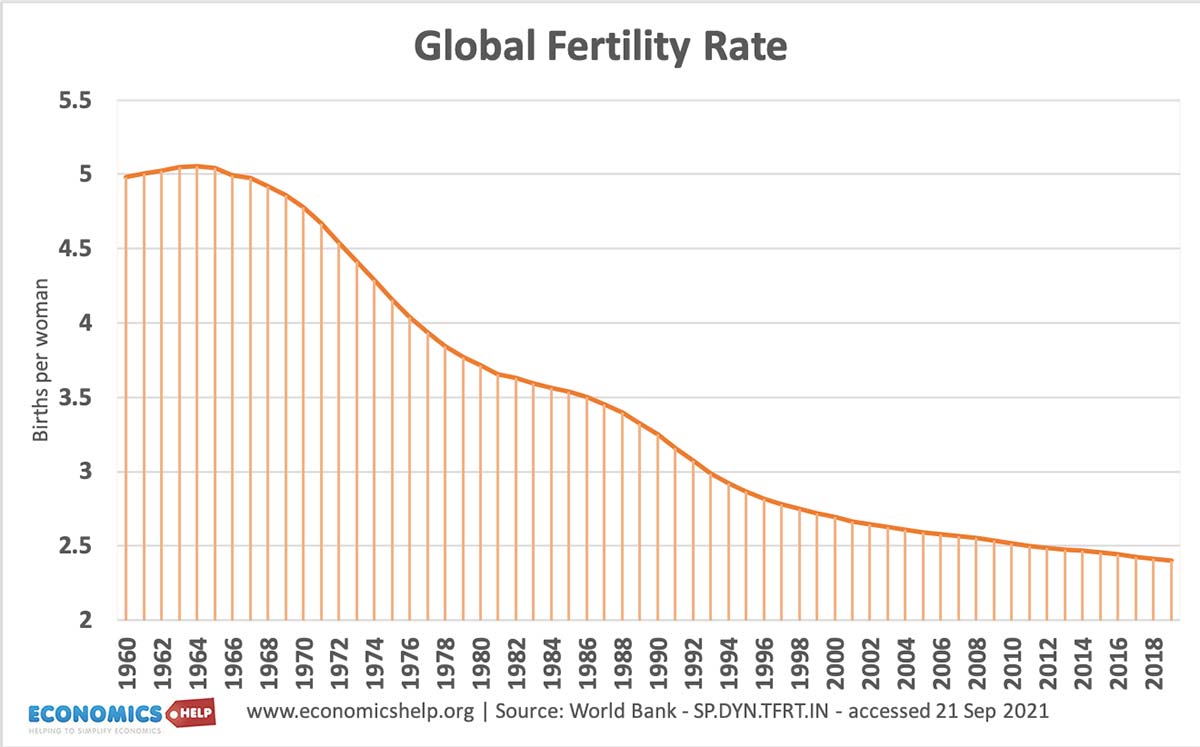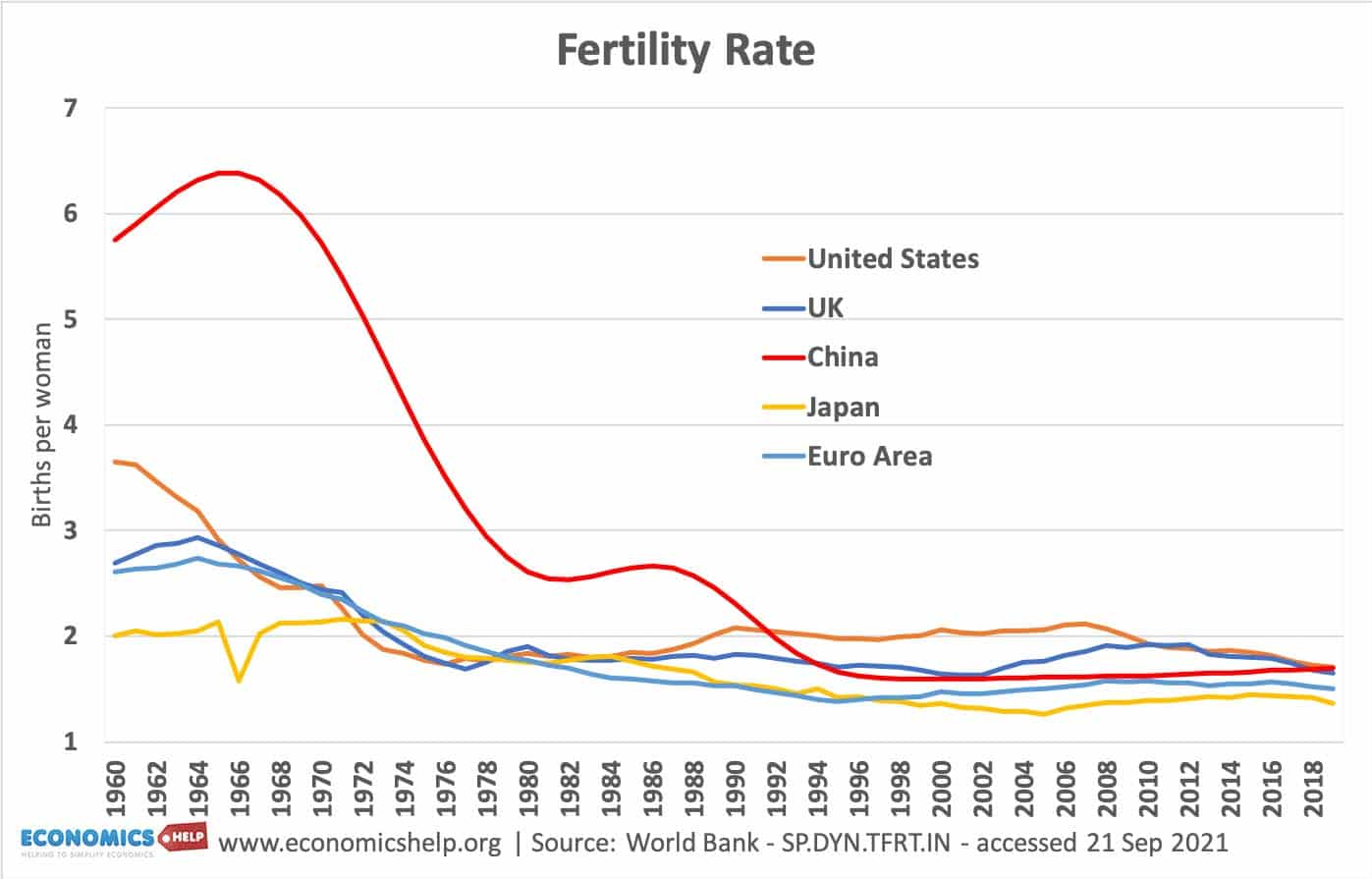In the past few decades, there has been a dramatic decline in global birth rates, with many developed economies seeing their birth rate fall well below the ‘replacement ratio’ of 2.1 – meaning that their population will be set to decline in future years. Italy gives a stark warning of the impact of a low birth rate – with its population set to fall from 61 million in 2017 to 28 million by 2100. Japan’s population is expected to fall from 128 million in 2017 to less than 53 million by 2100. This kind of population decline will have major impacts on society, the economy, tax revenues, and available workers.
There are several causes for falling birth rates. Some reflect positive reasons – higher incomes, improved education and improved access to health care and reproductive services. Falling birth rates have enabled many women to pursue a much greater range of economic and social activities. It also reflects that young children are going to school rather than going to work.
However, the dramatic fall in birth rates is also due to increased anxiety and concern over the future of the planet and economic prospects. In western world, having children is often seen as not economically viable because of the high cost of living involved in bringing up children. It is ironic that higher living standards led to falling birth rates, but now the cost of housing and living and discouraging many potential parents from having children.
Since 2020, Covid has accelerated this decline in birth rates, with the uncertainty over the future discouraging many young people from having children.
Video summary
Problems of falling birth rate
Increased share of retired people. The most striking feature of a low birth rate is that it will create a rising share of people over 65, and an inverted population pyramid. In the 1960s, there were six people of working age for every retired person. In 2021, that is three-to-one. By 2035, there will be two working-age persons for every retired person (We Forum). This has profound implications for health care, government spending and tax revenues.
Pressure on government spending. With an ageing population, the government will need to spend more on pensions and health care (old people disproportionately use health care services and social care). At the same time, there will be fewer young people to pay income tax. It gives the government an unwelcome headache and may require higher taxes on a shrinking workforce. If there is strong economic growth and the population decline is mild, this ageing population will be manageable. However, there are concerns that the post-war rates of economic growth have slipped away and we are entering a period of secular stagnation – so we cannot rely on high growth
The costs of an ageing population will be offset to some extent by less spending on education for young people. But, the extra spending on health and social care will far outweigh the lower spending on education.
Less innovation. Young people are more likely to be entrepreneurs, innovators and take risks to develop new technologies and business. With less young people, the potential ‘brain pool’ will be less – giving relatively few ideas for improving living standards.
Benefits of falling birth rates
Higher wages. Fewer workers, in theory, can command higher wages. With a shortage of workers, they will be in a position to bargain for higher wages and enjoy higher living standards. this could help reduce the relative decline many workers have faced in recent decades.
However, it is not guaranteed there will be rising real wages. There will be other factors affecting wage rates, such as the degree of automation of jobs and the distribution of income within society. E.g. firms with monopsony power can keep wages low – even with a shrinking working population. Also, it depends on whether a higher tax burden will offset any rise in wages.
Less pressure on the environment. The world faces great pressure on environmental sustainability from a growing population. Global warming, desertification, loss of farmland, pollution and use of non-renewable materials – all these environmental problems will be lessened by a fall in the global population. As living standards continue to rise and the quantity of consumption increases, the total population becomes even more significant.
Risk of famine and drought may wane. With falling populations, there will be less pressure on limited farmland and water supplies will face less competition. Access to drinking water is becoming a major issue, especially in areas which are experiencing desertification.
Immigrants welcomed. With high population growth and high density, there is a great unwillingness of developed countries to take refugees or welcome immigrants. However, if populations fall so much there is a shortage of workers, attitudes to immigration may change and there even may be competition to attract migrants rather than resistance.
Greater choice and freedoms for women. As birth rates fall in the developing world, it gives women more freedom to pursue economic autonomy, gain education and pursue a career. It also increases the ability for children to gain a good education. Often high birth rates in less developed countries is associated with the economic necessity of having large families to work in agriculture and in the home. As birth rates fall, it is possible to educate young children rather than going to work early.
Other impacts
A shift in the global population. China’s population growth has become negative very quickly and they are now estimated to be losing roughly 400,000 people a year. By 2100, China could lose between 600 and 700 million people. South Korea with the world’s lowest birth rate of 1.0 could see the population halve within 50 years. 23 countries, such as Spain, Japan and Italy could see their populations halve by 2100. (Fertility Rate, BBC)
By contrast the population of sub-Saharan Africa is set to continue to grow and will grow to 3 billion by 2100. Nigeria will become one of the world’s most populous countries with over 700 million by 2021. (Fertility Rate, BBC)
Some counties will see a more manageable decline. The UK is predicted to peak at 75 million before slowly falling to 71 million. The US and Canada have also a slower fall predicted.
However, Covid and concern over the environment has seen a faster pace of decline and birth rates have fallen more than expected. Also, policies to change the birth rate have generally proved ineffective. Whilst better childcare and low tax could provide some marginal incentives, there has been a strong change in the culture towards having children and this can be very hard to reverse – no matter how many financial benefits are offered.
Related



Your quote is backwards up above: “By 2035, there will be two retired persons for every working person” is reversed. The article you link to says there will be 2 working persons for every retired person.
thank you. Fixed.